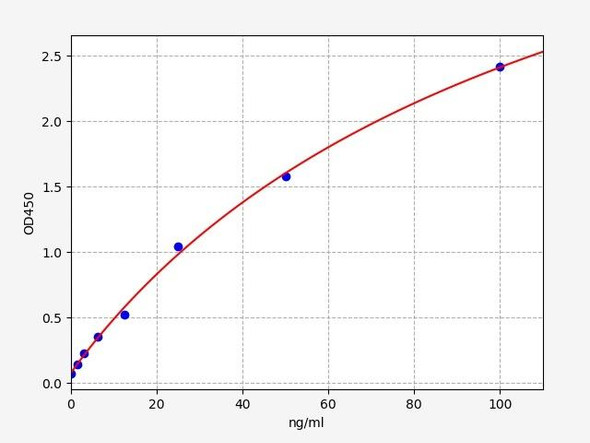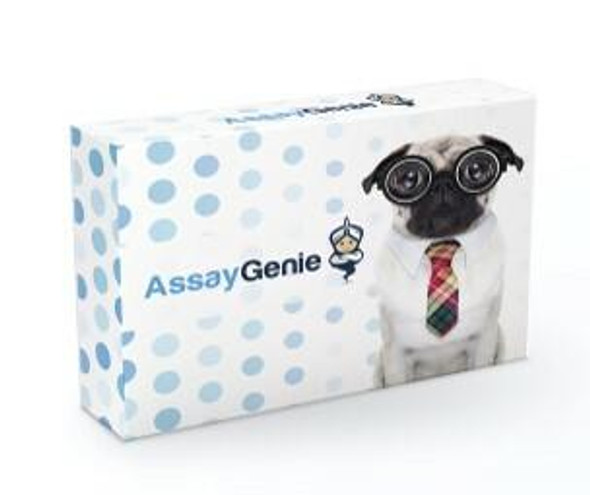Description
Human CFP (Complement Factor P) ELISA Kit
The Human CFP (Complement Factor P) ELISA Kit is specially designed for the precise quantification of complement factor P levels in human samples such as serum, plasma, and cell culture supernatants. This kit offers exceptional sensitivity and specificity, guaranteeing accurate and consistent results for various research applications.Complement factor P is a key component of the complement system, playing a vital role in immune response and inflammation. Dysregulation of complement factor P has been implicated in various diseases, including autoimmune disorders, infections, and inflammatory conditions, highlighting its importance as a biomarker for disease diagnosis and therapeutic development.
With its advanced technology and reliable performance, the Human CFP ELISA Kit is an indispensable tool for researchers studying the role of complement factor P in health and disease. Trust in this kit to deliver precise and reliable results for your experiments.
| Assay type: | Sandwich |
| Format: | 96T |
| Assay time: | 4.5h |
| Reactivity: | Human |
| Detection Method: | Colormetric |
| Detection Range: | 1.56-100 ng/mL |
| Sensitivity: | 0.94 ng/mL |
| Sample Volume Required Per Well: | 100µL |
| Sample Type: | Serum, plasma and other biological fluids |
| Specificity: | This kit recognizes Human CFP in samples. No significant cross-reactivity or interference between Human CFP and analogues was observed. |
This ELISA kit uses Sandwich-ELISA as the method. The micro ELISA plate provided in this kit has been pre-coated with an antibody specific to Human CFP. Standards or samples are added to the appropriate micro ELISA plate wells and combined with the specific antibody. Then a biotinylated detection antibody specific for Human CFP and Avidin-Horseradish Peroxidase (HRP) conjugate are added to each micro plate well successively and incubated. Free components are washed away. The substrate solution is added to each well. Only those wells that contain Human CFP, biotinylated detection antibody and Avidin-HRP conjugate will appear blue in color. The enzyme-substrate reaction is terminated by adding Stop Solution and the color turns yellow. The optical density (OD) is measured spectrophotometrically at a wavelength of 450 nm ± 2 nm. The OD value is proportional to the concentration of Human CFP. The concentration of Human CFP in samples can be calculated by comparing the OD of the samples to the standard curve.
| UniProt Protein Function: | CFP: A positive regulator of the alternate pathway of complement. It binds to and stabilizes the C3- and C5-convertase enzyme complexes. Defects in CFP are the cause of properdin deficiency (PFD). PFD results in higher susceptibility to bacterial infections; especially to meningococcal infections. Three phenotypes have been reported: complete deficiency (type I), incomplete deficiency (type II), and dysfunction of properdin (type III). |
| UniProt Protein Details: | Protein type:Secreted, signal peptide; Secreted Chromosomal Location of Human Ortholog: Xp11. 4 Cellular Component: extracellular matrix; extracellular space; endoplasmic reticulum lumen; extracellular region Biological Process: protein amino acid O-linked glycosylation; cellular protein metabolic process; defense response to bacterium; complement activation, alternative pathway; regulation of complement activation; innate immune response; immune response; post-translational protein modification; complement activation Disease: Properdin Deficiency, X-linked |
| NCBI Summary: | This gene encodes a plasma glycoprotein that positively regulates the alternative complement pathway of the innate immune system. This protein binds to many microbial surfaces and apoptotic cells and stabilizes the C3- and C5-convertase enzyme complexes in a feedback loop that ultimately leads to formation of the membrane attack complex and lysis of the target cell. Mutations in this gene result in two forms of properdin deficiency, which results in high susceptibility to meningococcal infections. Multiple alternatively spliced variants, encoding the same protein, have been identified. [provided by RefSeq, Feb 2009] |
| UniProt Code: | P27918 |
| NCBI GenInfo Identifier: | 464473 |
| NCBI Gene ID: | 5199 |
| NCBI Accession: | P27918. 2 |
| UniProt Secondary Accession: | P27918,O15134, O15135, O15136, O75826, |
| UniProt Related Accession: | P27918 |
| Molecular Weight: | 469 |
| NCBI Full Name: | Properdin |
| NCBI Synonym Full Names: | complement factor properdin |
| NCBI Official Symbol: | CFP |
| NCBI Official Synonym Symbols: | BFD; PFC; PFD; PROPERDIN |
| NCBI Protein Information: | properdin; complement factor P; properdin P factor, complement |
| UniProt Protein Name: | Properdin |
| UniProt Synonym Protein Names: | Complement factor P |
| Protein Family: | Properdin |
| UniProt Gene Name: | CFP |
| UniProt Entry Name: | PROP_HUMAN |
As the OD values of the standard curve may vary according to the conditions of the actual assay performance (e. g. operator, pipetting technique, washing technique or temperature effects), the operator should establish a standard curve for each test. Typical standard curve and data is provided below for reference only.
| Concentration (ng/mL) | O.D | Average | Corrected |
| 100 | 2.418 2.472 | 2.445 | 2.36 |
| 50 | 1.724 1.744 | 1.734 | 1.649 |
| 25 | 0.982 0.964 | 0.973 | 0.888 |
| 12.5 | 0.481 0.521 | 0.501 | 0.416 |
| 6.25 | 0.3 0.292 | 0.296 | 0.211 |
| 3.13 | 0.202 0.174 | 0.188 | 0.103 |
| 1.56 | 0.137 0.139 | 0.138 | 0.053 |
| 0 | 0.081 0.089 | 0.085 | -- |
Precision
Intra-assay Precision (Precision within an assay): 3 samples with low, mid range and high level Human CFP were tested 20 times on one plate, respectively.
Inter-assay Precision (Precision between assays): 3 samples with low, mid range and high level Human CFP were tested on 3 different plates, 20 replicates in each plate.
| Intra-assay Precision | Inter-assay Precision | |||||
| Sample | 1 | 2 | 3 | 1 | 2 | 3 |
| n | 20 | 20 | 20 | 20 | 20 | 20 |
| Mean (ng/mL) | 5.51 | 8.56 | 47.05 | 5.36 | 7.87 | 47.16 |
| Standard deviation | 0.35 | 0.35 | 2.33 | 0.36 | 0.34 | 1.80 |
| C V (%) | 6.35 | 4.09 | 4.95 | 6.72 | 4.32 | 3.82 |
Recovery
The recovery of Human CFP spiked at three different levels in samples throughout the range of the assay was evaluated in various matrices.
| Sample Type | Range (%) | Average Recovery (%) |
| Serum (n=5) | 90-105 | 98 |
| EDTA plasma (n=5) | 87-99 | 94 |
| Cell culture media (n=5) | 86-99 | 91 |
Linearity
Samples were spiked with high concentrations of Human CFP and diluted with Reference Standard & Sample Diluent to produce samples with values within the range of the assay.
| Serum (n=5) | EDTA plasma (n=5) | Cell culture media (n=5) | ||
| 1:2 | Range (%) | 94-107 | 91-103 | 92-106 |
| Average (%) | 102 | 97 | 98 | |
| 1:4 | Range (%) | 92-105 | 82-94 | 86-97 |
| Average (%) | 97 | 86 | 92 | |
| 1:8 | Range (%) | 85-100 | 85-99 | 87-97 |
| Average (%) | 92 | 92 | 92 | |
| 1:16 | Range (%) | 95-106 | 82-94 | 88-102 |
| Average (%) | 100 | 88 | 94 |
An unopened kit can be stored at 4°C for 1 month. If the kit is not used within 1 month, store the items separately according to the following conditions once the kit is received.
| Item | Specifications | Storage |
| Micro ELISA Plate(Dismountable) | 8 wells ×12 strips | -20°C, 6 months |
| Reference Standard | 2 vials | |
| Concentrated Biotinylated Detection Ab (100×) | 1 vial, 120 µL | |
| Concentrated HRP Conjugate (100×) | 1 vial, 120 µL | -20°C(shading light), 6 months |
| Reference Standard & Sample Diluent | 1 vial, 20 mL | 4°C, 6 months |
| Biotinylated Detection Ab Diluent | 1 vial, 14 mL | |
| HRP Conjugate Diluent | 1 vial, 14 mL | |
| Concentrated Wash Buffer (25×) | 1 vial, 30 mL | |
| Substrate Reagent | 1 vial, 10 mL | 4°C(shading light) |
| Stop Solution | 1 vial, 10 mL | 4°C |
| Plate Sealer | 5 pieces | |
| Product Description | 1 copy | |
| Certificate of Analysis | 1 copy |
- Set standard, test sample and control (zero) wells on the pre-coated plate and record theirpositions. It is recommended to measure each standard and sample in duplicate. Note: addall solutions to the bottom of the plate wells while avoiding contact with the well walls. Ensuresolutions do not foam when adding to the wells.
- Aliquot 100 µL of standard solutions into the standard wells.
- Add 100 µL of Sample / Standard dilution buffer into the control (zero) well.
- Add 100 µL of properly diluted sample (serum, plasma, tissue homogenates and otherbiological fluids) into test sample wells.
- Cover the plate with the sealer provided in the kit and incubate for 90 min at 37 °C.
- Aspirate the liquid from each well, do not wash. Immediately add 100 µL of BiotinylatedDetection Ab working solution to each well. Cover the plate with a plate seal and gently mix. Incubate for 1 hour at 37 °C.
- Aspirate or decant the solution from the plate and add 350 µL of wash buffer to each welland incubate for 1-2 minutes at room temperature. Aspirate the solution from each well andclap the plate on absorbent filter paper to dry. Repeat this process 3 times. Note: a microplatewasher can be used in this step and other wash steps.
- Add 100 µL of HRP Conjugate working solution to each well. Cover with a plate seal andincubate for 30 min at 37 °C.
- Aspirate or decant the solution from each well. Repeat the wash process for five times asconducted in step 7.
- Add 90 µL of Substrate Reagent to each well. Cover with a new plate seal and incubate forapproximately 15 min at 37 °C. Protect the plate from light. Note: the reaction time can beshortened or extended according to the actual color change, but not by more than 30min.
- Add 50 µL of Stop Solution to each well. Note: Adding the stop solution should be done inthe same order as the substrate solution.
- Determine the optical density (OD value) of each well immediately with a microplate readerset at 450 nm.









